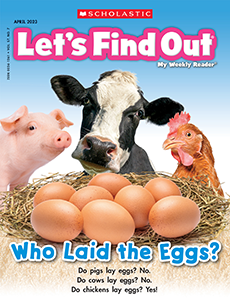A guide for using our resources
Children will discover how the spotted skunk defends against predators.
Vocabulary: warning
Science Focus: animal defenses
Simple, spectacular ideas to boost your lessons.
Paired Texts: If You Wake a Skunk by Carol Doeringer
Paired Texts: If You Wake a Skunk by Carol Doeringer
- In this cute rhyming story, two campers spot a spotted skunk! Will things get stinky? The book also features skunk facts in the back.
Scavenger Hunt: Pages 2-3
Scavenger Hunt: Pages 2-3
- Use pages 2-3 of the issue to do this scavenger hunt as a group.
- Find the heading. Underline it.
- Find the picture where the skunk is doing a handstand. Put a ✔on it.
- In the green box, find two words that are opposites. (big, little) Circle them.
- Look at the sidebar. Point to the animal that is called “the stinker of the forest.”
Hands-on Activity: Pin the Tail on the Skunk
Hands-on Activity: Pin the Tail on the Skunk
Skill: following directions
Materials: Pin the Tail on the Skunk skill sheets, scissors
- When a spotted skunk is in danger, it does a handstand. Its big, bushy tail stands straight up! This makes the skunk look bigger and warns predators to back off. If the predator persists, the skunk sprays. Explore this concept and have some fun with this stinky twist on a classic party game!
- Cut out the skunk’s body and tail and and attach the body to the board or wall. Place some removable adhesive on the back of the tail and show children where it belongs—it should stick straight up between the skunk's back legs.
- Blindfold the first player and spin them around. Hand them the tail and send them off to try to pin the tail on the skunk! Then remove the blindfold to see how close they got to the right spot.
- Let each child have a turn. Whenever a child pins the tail on the skunk, children can pretend the skunk sprayed and call out “Pee-yew!"
